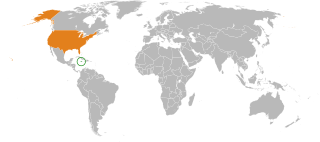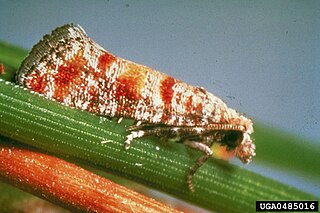Related Research Articles

Manduca rustica, the rustic sphinx, is a moth of the family Sphingidae. The species was first described by Johan Christian Fabricius in 1775.

British America comprised the colonial territories of the British Empire in America from 1607 to 1783. These colonies were formally known as British America and the British West Indies before the Thirteen Colonies declared their independence in the American Revolutionary War (1775–1783) and formed the United States of America. After the American Revolution, the term British North America referred to the remainder of Great Britain's Canadian possessions. That term was first used informally in 1783, but it was uncommon before the Report on the Affairs of British North America (1839), generally known as the Durham Report.
Jamaican American or Jamerican are an ethnic group of Caribbean Americans who have full or partial Jamaican ancestry. The largest proportions of Jamaican Americans live in South Florida and New York City, both of which have been home to large Jamaican communities since the 1950s and 60s. There are also communities of Jamaican Americans residing in Massachusetts, Connecticut, Los Angeles, Tampa, Orlando, Miami, Jacksonville, Baltimore, Washington, D.C., Atlanta, Charlotte, Chicago, Cleveland, Columbus, Cincinnati, Detroit, New York City, Western New York, Rhode Island, Philadelphia, Pittsburgh, Delaware and New Jersey.

Jamaica–United States relations are bilateral relations between Jamaica and the United States.

Fissicrambus profanellus is a moth of the family Crambidae. It is found in the southern part of the United States, the Caribbean and Central America.

Rhyacionia frustrana, the Nantucket pine tip moth, is a moth of the family Tortricidae. It is found in the United States from Massachusetts south to Florida, west to Missouri, Oklahoma, Texas and California. It is also found in the Dominican Republic, Cuba, Jamaica, Mexico (Oaxaca), Guatemala, Honduras and Nicaragua.
Hellula phidilealis, the cabbage budworm moth, is a moth of the family Crambidae. It is found in tropical and subtropical America. From the southern United States, north in the east to North Carolina, south through southwestern Mexico to northern South America, including several islands in the Caribbean.
Stenoptilia pallistriga is a moth of the family Pterophoridae described by William Barnes and James Halliday McDunnough in 1913. It is known from Dominica, Ecuador, Jamaica, Paraguay and Suriname. It is also found in the United States in Florida and Mississippi.
Anypsipyla is a monotypic snout moth genus described by Harrison Gray Dyar Jr. in 1914. Its only species, Anypsipyla univitella, was described by the same author in the same year. It is found in Central America, South America and has also been recorded from Cuba, Mexico, Jamaica and Florida in the southern United States.
Eublemma recta, the straight-lined seed moth, is a moth of the family Erebidae. The species was first described by Achille Guenée in 1852. It is found in the United States from South Carolina to Florida and west to Texas. It is also found south to Argentina, on Cuba, Jamaica and Puerto Rico.

Melipotis acontioides, the royal poinciana moth, is a species of moth in the family Erebidae. It was first described by Achille Guenée in 1852. The species is found from the southern United States through Mexico and Central America to Brazil, Argentina and the Galápagos Islands. It is also found in the Caribbean, including Cuba and the British Virgin Islands, Jamaica and Puerto Rico.

Ptichodis herbarum, the common ptichodis moth, is a moth in the family Erebidae. It is found in the United States. It has also been recorded from Jamaica.

Ametris nitocris, the seagrape spanworm moth, is a moth of the family Geometridae. The species was first described by Pieter Cramer in 1780. It is found from the southern United States through Central America to South America. It is also found on the Antilles.
Conchylodes diphteralis is a moth in the family Crambidae. It was described by Carl Geyer in 1832. It is found from the southeastern United States, where it has been recorded from Florida, through the West Indies to South America.
Diacme mopsalis, the mopsalis diacme moth, is a moth in the family Crambidae. It was described by Francis Walker in 1859. It is found in South America, Central America, the Antilles and the southern United States, where it has been recorded from Arizona, Florida, Oklahoma and Texas.
Diacme phyllisalis is a moth in the family Crambidae. It was described by Francis Walker in 1859. It is found in Jamaica, Cuba and Mexico, as well the southeastern United States, where it has been recorded from Florida and Georgia.
Hileithia magualis is a moth in the family Crambidae. It was described by Achille Guenée in 1854. It is found in the southern United States, where it has been recorded from Alabama, Arizona, Florida, Mississippi, Missouri, New Mexico, Oklahoma and Texas. It is also found in the Dominican Republic, Jamaica and Cuba.

Lineodes fontella, the eastern lineodes moth, is a moth in the family Crambidae. It was described by Walsingham in 1913. It is found in the United States, where it has been recorded from Florida, North Carolina, South Carolina and Texas. Outside of the States, it is found in Jamaica, Cuba, the Dominican Republic, Mexico, Panama, Guatemala, Honduras, Brazil, French Guiana and Guyana.

Microthyris anormalis is a moth in the family Crambidae. It was described by Achille Guenée in 1854. It is found in French Guiana, Colombia, Ecuador, the Dominican Republic, Jamaica, Honduras, Panama, Costa Rica and the United States, where it has been recorded from Florida and Texas.

Havana Marguerite Solaun is a Jamaican professional footballer who plays as a midfielder for North Carolina Courage of the American National Women's Soccer League (NWSL) and the Jamaica women's national team.
References
- ↑ Nuss, M.; et al. (2003–2014). "GlobIZ search". Global Information System on Pyraloidea. Retrieved 2014-07-15.
- ↑ Moths of Jamaica
- ↑ Moth Photographers Group. Mississippi State University.
- ↑ BugGuide
| This Evergestinae-related article is a stub. You can help Wikipedia by expanding it. |